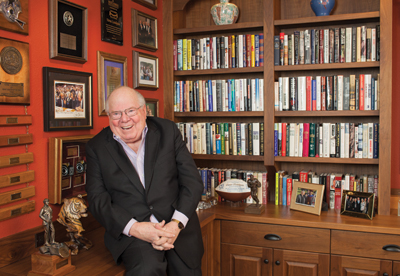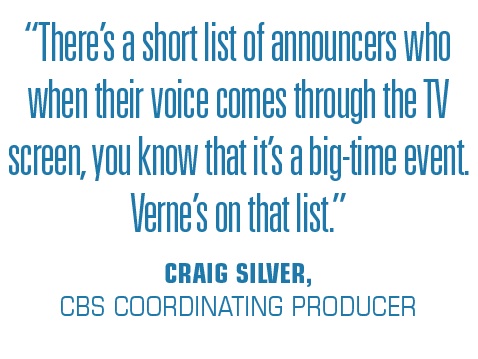The undefeated Ohio State Buckeyes faced a fourth-and-10 with a little more than two minutes remaining in December’s Big Ten championship game in Indianapolis. Ohio State trailed by 10, and a trip to the BCS National Championship Game hung in the balance.
More than 500 miles away, on the top floor of downtown Atlanta’s Commerce Club, Verne Lundquist was at an informal CBS party. Known as the voice of the SEC, he sat on the edge of his leather chair, glass of red wine in front of him. Lundquist stared intently at a TV screen that carried the Buckeyes’ game against Michigan State.
Earlier that evening, the 73-year-old Lundquist called a thrilling SEC championship game at the Georgia Dome, where Auburn outscored Missouri and won the SEC title. Now, he was surrounded by about two dozen CBS staffers, watching to see whether an Ohio State loss might pave the way for Auburn to represent the SEC in the BCS championship.
The room quieted as Ohio State quarterback Braxton Miller took the fourth-down snap. When Miller threw an incomplete pass, the CBS contingent exploded in cheers. Lundquist jumped out of his chair, high-fiving everyone around him — CBS producers and production assistants.
{podcast}
SBJ Podcast:
Writer John Ourand and Executive Editor Abraham Madkour discuss Verne Lundquist's career and the many memorable calls he's made.
“How about that,” he said, above the roar of the room. Auburn was going to the BCS title game, and the longtime voice of the conference could not have been happier.
Lundquist did not necessarily have a dog in the fight — the only bowl game he and Gary Danielson would call was the Sun Bowl between Virginia Tech and UCLA. But having completed his 14th year of calling SEC football games for CBS, Lundquist identifies closely with the conference and unabashedly celebrates when its football teams do well.
As midnight approached, the CBS party started winding down. Lundquist remained so energized that he contemplated calling his friend, SEC Commissioner Mike Slive, to revel in the outcome. He decided not to make the call because of the late hour. He would talk to Slive in the morning.
Having just completed his 50th year broadcasting sports, Lundquist remains one of the most recognizable voices on sports TV and has provided the soundtrack for some of the most memorable sports moments of the past five decades — from Jack Nicklaus’ final-round putt at The Masters’ 17th hole in 1986 (“Yes, sir!”) to Auburn’s miracle finish against Alabama last fall (“An answered prayer!”).
For a man who originally thought he’d follow in his father’s footsteps and become a Lutheran minister, Lundquist says he’s enjoying himself now more than at any of the other stops he’s had along the way.
“College football is the top sport to announce, and it’s not even close,” he said. “If you’re lucky, you get to forge really meaningful relationships in this business.”
‘THE SWEDE’
Like many broadcasters of his era, Lundquist’s story starts off in small radio and television stations in tiny markets, from Iowa’s WOC radio to KTBC, an Austin, Texas, radio and TV station owned by President Lyndon B. Johnson’s family.
In September of 1967, Lundquist caught on in Dallas, where his career started to take off as a sports director at TV station WFAA making $180 a week.
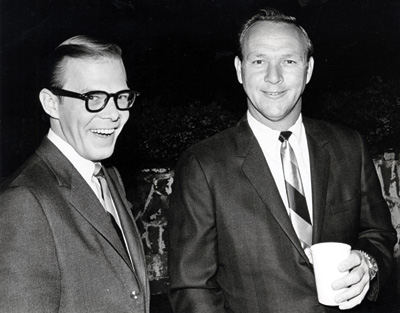 |
Throughout his career Lundquist (shown with a young Arnold Palmer) has covered everything from the NFL to the PGA Tour.
Photo: COURTESY OF CBS
|
During Lundquist’s second week on the job, the Dallas Cowboys’ public relations director, Curt Mosher, invited him to take the team’s chartered plane to its game in Washington. Lundquist accepted. On the plane, Mosher asked Lundquist to host the team’s postgame radio show in Washington.
Lundquist said yes, even though he didn’t have permission to appear on another station in the market. His station manager heard the postgame show and was so upset that Lundquist had Cowboys general manager Tex Schramm call to smooth things out.
“I told Tex that I had gotten in trouble for it,” Lundquist said. “He called and said, ‘We’d really like to have him as part of the broadcast.’ The station understood the benefits of it. I did the pre- and the postgame show for two years, in 1967 and 1968.”
The plan to use Lundquist fit Schramm’s strategy for the team’s radio broadcasts. As with Frank Glieber earlier, Schramm targeted the top sportscaster at Dallas TV stations to call Cowboys games on the radio.
“Every time people saw that guy on television, Tex wanted them to think ‘Cowboys,’” said Greg Aiello, the NFL’s senior vice president of communications, who worked for the Cowboys in the 1980s.
Lundquist caught on with the Cowboys when they were playing well, serving as a radio analyst on two Super Bowls as well as the Ice Bowl championship game between the Cowboys and Packers. Affectionately nicknamed “The Swede” — “back when you could have nicknames like that,” Aiello said — Lundquist was identified with the Cowboys, much as he now is identified with the Southeastern Conference.
But Lundquist had designs on a bigger platform. He wanted to do play-by-play for a national network. In 1972, he pursued a job that would take him to Los Angeles and, he thought, closer to a network announcing job.
He orally accepted an offer to replace Gil Stratton as the sports director of KNXT in Los Angeles.
“There’s a lot to be said for having your job interview at the Bel-Air Country Club,” Lundquist said. “Groucho Marx and Jack Benny were having lunch over in the corner. I thought, ‘I could get used to this.’”
When he got back to Dallas, though, Schramm countered with a pitch that persuaded Lundquist to stay in Dallas, arguing that he was closer to a network job in Dallas than he would be in Los Angeles.
Lundquist recalled Schramm telling him, “If you go out to Los Angeles, perhaps you’ve heard of guys like Vin Scully and Dick Enberg and Chick Hearn. There are probably 30 guys right behind them who are waiting for those jobs. If you go out there with no play-by-play experience, I don’t like your odds. I’m prepared to make you the play-by-play guy. If you can do it, the networks will find you because we’re going to be pretty good. And if you can’t do it, at least you’ll know because you had the opening and the opportunity.”
Two years later, as Schramm predicted, ABC came calling, asking Lundquist to do some college football games. He stayed at ABC for eight years, eventually landing at CBS in 1982, which — other than a foray to call NFL games for Turner Sports in the 1990s — is where he has stayed ever since, providing the soundtrack for some of the biggest moments in sports over the past three decades.
By 2000, Lundquist had carved out a nice niche at CBS. He was paired with Dan Dierdorf as the network’s No. 2 NFL broadcast team. He also was a big part of CBS’s golf coverage, was a mainstay on its NCAA tournament coverage and was comfortable with his place in the business.
“I was back where I always felt I belonged,” Lundquist said. “I’m a CBS guy through and though. Things were great.”
Over the Christmas holidays in 2000, however, CBS Sports Chairman Sean McManus made a decision that changed Lundquist’s career path.
‘UNCLE VERNE’
When CBS picked up NFL rights in 1998, many of NBC’s NFL announcers became available. One that McManus targeted, Dick Enberg, became available in 2000. McManus wanted to hire Enberg to do play-by-play for CBS’s No. 2 NFL team. That move would free up Lundquist to become the lead broadcaster on CBS’s Saturday SEC package.
McManus was certain this would be a good move for Lundquist. The problem was convincing him that it wasn’t a demotion.
“At the time, it was a very tough phone call to make, especially over the holidays,” McManus said.
McManus was spending the holidays at his parents’ home outside of Baltimore.
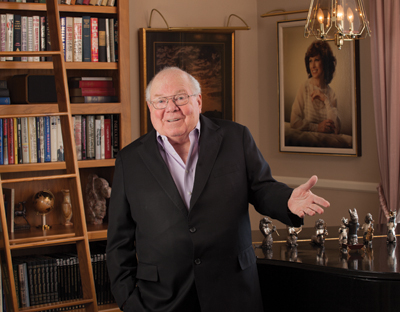 |
These days, Lundquist’s focus is on college football as lead announcer for the “SEC on CBS” and college basketball during the network’s coverage of the NCAA Tournament.
Photo by: DAVID PATTERSON
|
McManus’ father is Jim McKay, a legendary broadcaster whom Lundquist considered a mentor.
McManus recalls calling Lundquist, telling him, “You’re going to think that this is not a very good phone call. But in the end, this is going to be a really good career move for you.”
Lundquist said he hung up after the five- to 10-minute conversation and said to his wife, Nancy, “Pack your bags for Tuscaloosa.”
Lundquist was not happy about giving up the NFL. He felt like he settled into a good routine as the network’s No. 2 NFL broadcaster.
But he did have an idea of what to expect. He had called some SEC football games in the past, though never as the lead voice of a network college football package, and he remembered doing a Florida-Tennessee game just a few months earlier at Knoxville’s Neyland Stadium. Before a raucous crowd of 108,000, Florida receiver Jabar Gaffney caught a controversial touchdown in the final seconds to win the game.
“The place went crazy,” Lundquist recalls. “We got off the air and I looked at Todd [Blackledge], and I said, ‘Are they all like this?’ He said, ‘Enough of them.’ I thought, ‘God almighty.’”
After 14 years, Lundquist says he does not miss doing NFL games at all. He has embraced the passion and pageantry of college football. And he has no qualms about being identified closely with a college conference — so much so that the conference’s fans refer to him as “Uncle Verne.” Lundquist embraces the nickname and credits the blog “Every Day Should Be Saturday” for coming up with it.
“There’s a warmth in that, and I’m appreciative of it,” he said. “The move to the SEC has just been the best thing professionally that’s ever happened. I’d been in network television for, to that point, 26 years. I’d never headed up a single property.”
‘HOW DO YOU DO?’
Lundquist was all smiles when he walked out of the broadcast booth in the Georgia Dome after Auburn won the SEC title game. He had just called an exhilarating game — one that featured a combined 101 points and 1,211 yards of offense.
Lundquist clearly was having fun, as the telecast included several of his trademark expressions — “Wow!” and “How DO you do?”
But when asked to rate his performance, Lundquist’s smile disappeared. He shook his head and grimaced. During the game, he misidentified some players and called some others the wrong name.
“I made some mistakes today,” he said. “I thought I did a good job. But it’s those mistakes that eat at you.”
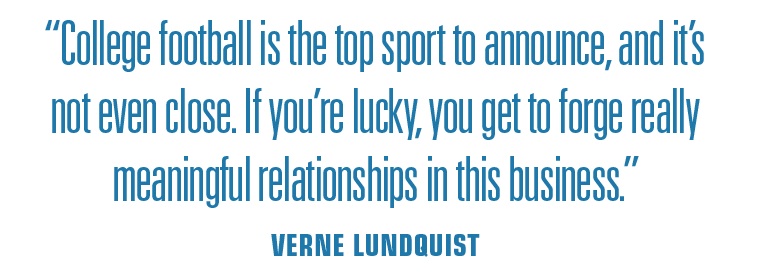
Lundquist, who describes his announcing style as minimalist, had similar second thoughts after his call at the end of the Alabama-Auburn game, when Auburn’s Chris Davis returned a missed field goal 109 yards for a game-winning touchdown as time expired.
“On the way. No. Return by Chris Davis. Davis goes left. Davis gets a block. Davis has another block. Chris Davis! No flags! Touchdown, Auburn! An answered prayer!”
“The only thing I think I would add is somewhere when he got to the 50, I would like to have said, ‘Unless he falls, he scores,’” Lundquist said. “Just something to give it a context instead of just the repetition of his name. That would probably be the only thing. I thought it was minimalist.”
Social media sites light up with vitriol when Lundquist calls a game, which is not necessarily unusual. Many announcers are vilified on Twitter and Facebook. Lundquist says he does not keep up with those comments since he does not have a Twitter or Facebook account. The opinions that really matter — the ones from his bosses’ and colleagues’ view — are universally positive. They are effusive in their praise, something that’s important for an announcer who has one more year left on his contract.
“He’s right at the top of the announcing chain,” McManus said. “Look at his consistency over so many years.”
Craig Silver, CBS’s coordinating producer for college sports, who has worked with Lundquist since the 1980s, sounds the same theme.
“There’s a short list of announcers who when their voice comes through the TV screen, you know that it’s a big-time event,” he said. “Verne’s on that list.”
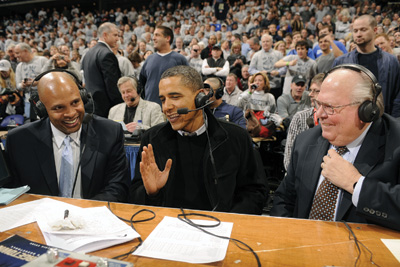 |
Lundquist and partner Clark Kellogg (left) interview President Barack Obama during a 2010 college basketball game.
Photo by: GETTY IMAGES
|
Lundquist says that he’s enjoying life much more now than in the earlier days of his career. Much of that enjoyment comes from being associated with college football’s top conference and the celebrity that comes with that.
The day before the SEC championship, Commissioner Slive spotted Lundquist as he stood on the Georgia Dome field waiting for Missouri to participate in a walk-through practice. Slive smiled and told the group he was with, “I want to introduce you to a real superstar.” He then introduced his group to Lundquist.
Lundquist and Slive have become close friends — so much so that Slive’s daughter asked Lundquist to narrate a birthday video for the commissioner’s wife, Liz, a few years ago. Lundquist happily complied.
“He is a wonderful wordsmith,” Slive said. “We’ve had a friendship that’s evolved throughout my 12-year tenure here.”
As the friendship has evolved, so, too, has Lund-quist’s close association with the Southeastern Conference, a conference that has posted college football’s biggest TV ratings during the past several years. Lundquist said that he and his broadcast partner, Gary Danielson, have benefited from that popularity as much as anyone.
“Our profile has been raised and we have now become a very important part of the product that CBS Sports puts on the air,” he said. “There’s a lot of gratification in that. At this stage of my career, to be so closely regarded with something like this is a really gratifying thing.”


